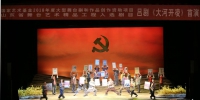中国日报:山东青州传统文化保护与旅游结合开创非遗保护新模式
Zhao Xingtang and his students play cuoqin during a performance in Qingzhou
A local woman demonstrates her embroidery skills
An elderly Qingzhou man walks in the cultural-heritage street, carrying the old-fashioned equipment of an itinerant barber
A city offers daily glimpses of an ancient lifestyle that is rarely visible in modern
While on an electric-car ride through the alleys of ancient Qingzhou city in eastern
Zhao Lianju, 64, has learned bajiaogu (drum) singing of the ethnic Manchu people. The singing, which dates back to the Qing Dynasty (1644-1911), was taught to him by his grandfather when he was a child. Now, he wears a traditional long gown and uses a snakeskin tabor while performing.
"As long as visitors from afar still cherish the art form, I am satisfied," Zhao says, adding that some of the local youth do not enjoy the singing.
He is listed as a province-level inheritor of intangible cultural heritage.
His daughter, however, has taken to it, he says, although the same can't be said of many other families with legacies in bajiaogu singing.
Historical records suggest that Qingzhou was among
But despite its rich traditions, Qingzhou was long seen as "a famous ancient city without (modern) vitality", according to Li Jiangtao, head of the city's cultural center. Which is why, he says, in the past decade field research on intangible cultural heritage was carried out by the local government.
"We knew that there were many traditions that were hidden in the grassroots, but we needed to find them," he says. "If we didn't hurry, everything would be lost."
Cuoqin, a musical instrument with more than two dozen strings that looks like a combination of violin and the Chinese guqin, is one such discovery of the project. The cuoqin was popular in ancient Qingzhou after originating from the Warring States (475-221 BC), and was described by some scholars as among the world's oldest string instruments.
However, when a cuoqin was found in Zhao Xingtang's home in 2005, he wasn't able to play it. His grandfather was a cuoqin performer, but the skill wasn't naturally inherited by younger members of the family.
"I have to rummage through my childhood memories to learn it all by myself again," he says, adding that these days he has some 20 students that he can teach it to. "The gap was gradually filled."
Unfortunately, even if some instruments have been recovered, traditional melodies have been lost. Today, the performers use modern lyrics.
More than 700 items of Qingzhou's intangible cultural heritage have been categorized, but restorers are still faced with the common dilemma: how to prolong the items' lives. Like many other places in
An ancient-style neighborhood was completed in Qingzhou in 2013, and since then more than 40 key inheritors of the intangible cultural heritage are paid 50 yuan ($8.20) a day by the local government to perform in front of visitors for five hours a day.
At China's third national exposition on intangible cultural heritage, held recently in the provincial capital Jinan, Xu Xianghong, head of Shandong provincial cultural department, called the ancient skills and arts the city's lifestyle. "It was unfair to simply demolish them without serious consideration."
"We need to create an atmosphere to balance their original characteristics and the younger generation's aesthetic sense," Xu said at the event, urging private sector participation as well.
Perhaps, tourism is a way to preserve Qingzhou's culture.
"When there is protection and tourism, the different sectors will be encouraged to participate in the project due to the huge social and economic benefits," Li says. "It's difficult to tell people that dying traditions are precious through regular education in classes."
But when people come into direct contact with endangered culture, they will likely become more aware of the need to protect it, he adds.





